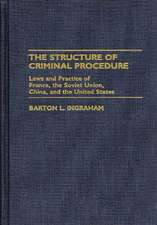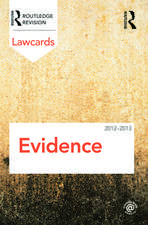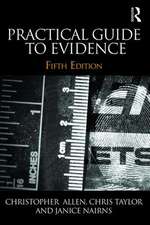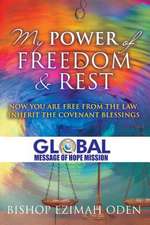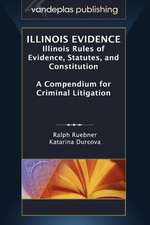The Ethics of Expert Evidence: The Library of Essays on Legal Ethics and the Enforcement of Law
Autor Emma Cunliffeen Limba Engleză Hardback – noi 2016
Preț: 1053.97 lei
Preț vechi: 1448.63 lei
-27% Nou
Puncte Express: 1581
Preț estimativ în valută:
201.70€ • 219.02$ • 169.43£
201.70€ • 219.02$ • 169.43£
Carte tipărită la comandă
Livrare economică 22 aprilie-06 mai
Preluare comenzi: 021 569.72.76
Specificații
ISBN-13: 9781472450739
ISBN-10: 1472450736
Pagini: 552
Dimensiuni: 174 x 246 x 43 mm
Greutate: 1.09 kg
Ediția:1
Editura: Taylor & Francis
Colecția Routledge
Seria The Library of Essays on Legal Ethics and the Enforcement of Law
Locul publicării:Oxford, United Kingdom
ISBN-10: 1472450736
Pagini: 552
Dimensiuni: 174 x 246 x 43 mm
Greutate: 1.09 kg
Ediția:1
Editura: Taylor & Francis
Colecția Routledge
Seria The Library of Essays on Legal Ethics and the Enforcement of Law
Locul publicării:Oxford, United Kingdom
Cuprins
The Ethics of Expert Evidence
Edited by Emma Cunliffe
Contents
Acknowledgements
Introduction
Part I: Conceptualizing the ethics of expert evidence
1. Joseph Sanders, Science, Law and the Expert Witness, Law & Contemporary Problems 72, 2009, 63 – 90.
2. Philip J. Candilis, The Revolution in Forensic Ethics: Narrative, Compassion and a Robust Professionalism, Psychiatric Clinics of North America 32, 2009, 423 – 435.
3. Ezra E. H. Griffith, Personal Narrative and an African-American Perspective on Medical Ethics, Journal of the American Academy of Psychiatry and Law 33, 2005, 371 – 381
4. Robert F. Taylor, A Comparative Study of Expert Testimony in France and the United States: Philosophical Underpinnings, History, Practice, and Procedure, Texas International Law Journal 31, 3, 1996, 181–213
Part II: Intellectual basis and role comprehension
5. Gary Edmond & Mehera San Roque, The Cool Crucible: Forensic Science and the Frailty of the Criminal Trial, Current Issues in Criminal Justice 24, 1, 2012, 51 – 68.
6. Simon A. Cole, Where the Rubber meets the Road: Thinking about Expert Evidence as Expert Testimony, Villanova Law Review 52, 2007, 803 – 842.
7. Emma Cunliffe, Independence, Reliability & Expert Testimony in Criminal Trials, Australian Journal of Forensic Sciences 45, 2013, 284 – 295.
8. Sheila Jasanoff, Research Subpoenas and the Sociology of Knowledge, Law & Contemporary Problems 59, 1996, 95 – 118.
9. Deirdre Dwyer, (Why) Are Civil and Criminal Expert Evidence Different?, Tulsa Law Review 43, 2007, 381 – 396.
10. Gary Edmond, Judging the Scientific and Medical Literature: Some Legal Implications of Changes to Biomedical Research and Publication, Oxford Journal of Legal Studies 28, 2008, 523 – 61.
11. William C. Thompson, Beyond Bad Apples: Analyzing the Role of Forensic Science in Wrongful Convictions, Southwestern Law Review 37, 2008, 1027 – 1050.
12. Itiel E. Dror, Practical Solutions to Cognitive and Human Factor Challenges in Forensic Science, Forensic Science Policy & Management: An International Journal 4, 2013, 105 – 113.
13. Mariana Valverde, Social Facticity and the Law: A Social Expert’s Eyewitness Account of Law, Social & Legal Studies 5, 1996, 201 – 217.
Part III: Case studies and debates
A: Humanities and social sciences
14. Richard J. Evans, History, Memory and the Law: The Historian as Expert Witness, History & Theory 41, 2002, 326 – 345.
15. Arthur J. Ray, Native History on Trial: Confessions of an Expert Witness, Canadian Historical Review 84, 2003, 255 – 73.
16. Gregory Mitchell, John Monahan & Laurens Walker, The ASA’s Missed Opportunity to Promote Sound Science in Court, Sociological Methods & Research 40, 2011, 605 – 620.
17. Laura Beth Nielson, Amy Myrick & Jill Weinberg, Siding with Science: In Defense of ASA’s Dukes v Walmart Amicus Brief, Sociological Methods & Research 40, 2011, 646 – 667.
B: Medicine
18. Stephen T. Goudge, ‘Effective Communication with the Criminal Justice System, Final Report of the Inquiry into Pediatric Forensic Pathology (Toronto: Queen’s Printer, 2008), pp. 406 – 436.
19. C. C. Meltzer et al, Guidelines for the Ethical Use of Neuroimages in Medical Testimony: Report of a Multidisciplinary Consensus Conference, American Journal of Neuroradiology 35, 2014, 632 – 637.
20. Robert K. Jackler & Hussein A. Samji, The Price Paid: Manipulation of Otolaryngologists by the Tobacco Industry to Obfuscate the Emerging Truth that Smoking Causes Cancer, Laryngoscope 122, 2012, 75 – 87.
21. Amar Jesani, Supreme Court Judgment on Medical Interrogation: On the Just Use of Science and the Ethics of Doctor Participation in Criminal Investigation, Indian Journal of Medical Ethics 7, 3, 2010, 139 – 142.
C: Psychology
22. Timothy M. Tippins & Jeffrey P. Wittmann, Empirical and Ethical Problems with Custody Recommendations: A Call for Clinical Humility and Judicial Vigilance Family Court Review 43, 2005, 193 – 222.
23. Isabel Grant, The "Syndromization" of Women’s Experience, University of British Columbia Law Review 25, 1991, 51 – 59.
24. Michael L. Perlin, Astrid Birgden & Kris Gledhill, The Witness Who Saw/ He Left No Doubt: A Comparative Consideration of Expert Testimony in Mental Disability Law Cases in Common and Civil Law Systems, Journal of Investigative Psychology & Offender Profiling 6, 2009, 59 – 88.
Index
Edited by Emma Cunliffe
Contents
Acknowledgements
Introduction
Part I: Conceptualizing the ethics of expert evidence
1. Joseph Sanders, Science, Law and the Expert Witness, Law & Contemporary Problems 72, 2009, 63 – 90.
2. Philip J. Candilis, The Revolution in Forensic Ethics: Narrative, Compassion and a Robust Professionalism, Psychiatric Clinics of North America 32, 2009, 423 – 435.
3. Ezra E. H. Griffith, Personal Narrative and an African-American Perspective on Medical Ethics, Journal of the American Academy of Psychiatry and Law 33, 2005, 371 – 381
4. Robert F. Taylor, A Comparative Study of Expert Testimony in France and the United States: Philosophical Underpinnings, History, Practice, and Procedure, Texas International Law Journal 31, 3, 1996, 181–213
Part II: Intellectual basis and role comprehension
5. Gary Edmond & Mehera San Roque, The Cool Crucible: Forensic Science and the Frailty of the Criminal Trial, Current Issues in Criminal Justice 24, 1, 2012, 51 – 68.
6. Simon A. Cole, Where the Rubber meets the Road: Thinking about Expert Evidence as Expert Testimony, Villanova Law Review 52, 2007, 803 – 842.
7. Emma Cunliffe, Independence, Reliability & Expert Testimony in Criminal Trials, Australian Journal of Forensic Sciences 45, 2013, 284 – 295.
8. Sheila Jasanoff, Research Subpoenas and the Sociology of Knowledge, Law & Contemporary Problems 59, 1996, 95 – 118.
9. Deirdre Dwyer, (Why) Are Civil and Criminal Expert Evidence Different?, Tulsa Law Review 43, 2007, 381 – 396.
10. Gary Edmond, Judging the Scientific and Medical Literature: Some Legal Implications of Changes to Biomedical Research and Publication, Oxford Journal of Legal Studies 28, 2008, 523 – 61.
11. William C. Thompson, Beyond Bad Apples: Analyzing the Role of Forensic Science in Wrongful Convictions, Southwestern Law Review 37, 2008, 1027 – 1050.
12. Itiel E. Dror, Practical Solutions to Cognitive and Human Factor Challenges in Forensic Science, Forensic Science Policy & Management: An International Journal 4, 2013, 105 – 113.
13. Mariana Valverde, Social Facticity and the Law: A Social Expert’s Eyewitness Account of Law, Social & Legal Studies 5, 1996, 201 – 217.
Part III: Case studies and debates
A: Humanities and social sciences
14. Richard J. Evans, History, Memory and the Law: The Historian as Expert Witness, History & Theory 41, 2002, 326 – 345.
15. Arthur J. Ray, Native History on Trial: Confessions of an Expert Witness, Canadian Historical Review 84, 2003, 255 – 73.
16. Gregory Mitchell, John Monahan & Laurens Walker, The ASA’s Missed Opportunity to Promote Sound Science in Court, Sociological Methods & Research 40, 2011, 605 – 620.
17. Laura Beth Nielson, Amy Myrick & Jill Weinberg, Siding with Science: In Defense of ASA’s Dukes v Walmart Amicus Brief, Sociological Methods & Research 40, 2011, 646 – 667.
B: Medicine
18. Stephen T. Goudge, ‘Effective Communication with the Criminal Justice System, Final Report of the Inquiry into Pediatric Forensic Pathology (Toronto: Queen’s Printer, 2008), pp. 406 – 436.
19. C. C. Meltzer et al, Guidelines for the Ethical Use of Neuroimages in Medical Testimony: Report of a Multidisciplinary Consensus Conference, American Journal of Neuroradiology 35, 2014, 632 – 637.
20. Robert K. Jackler & Hussein A. Samji, The Price Paid: Manipulation of Otolaryngologists by the Tobacco Industry to Obfuscate the Emerging Truth that Smoking Causes Cancer, Laryngoscope 122, 2012, 75 – 87.
21. Amar Jesani, Supreme Court Judgment on Medical Interrogation: On the Just Use of Science and the Ethics of Doctor Participation in Criminal Investigation, Indian Journal of Medical Ethics 7, 3, 2010, 139 – 142.
C: Psychology
22. Timothy M. Tippins & Jeffrey P. Wittmann, Empirical and Ethical Problems with Custody Recommendations: A Call for Clinical Humility and Judicial Vigilance Family Court Review 43, 2005, 193 – 222.
23. Isabel Grant, The "Syndromization" of Women’s Experience, University of British Columbia Law Review 25, 1991, 51 – 59.
24. Michael L. Perlin, Astrid Birgden & Kris Gledhill, The Witness Who Saw/ He Left No Doubt: A Comparative Consideration of Expert Testimony in Mental Disability Law Cases in Common and Civil Law Systems, Journal of Investigative Psychology & Offender Profiling 6, 2009, 59 – 88.
Index
Notă biografică
Emma Cunliffe is an Associate Professor in the Allard School of Law, University of British Columbia, Canada and a Senior Visiting Fellow at the School of Law, University of New South Wales.
Descriere
What are the key components of a legal and institutional culture that encourages the production and use of ethical expert testimony? What is the proper balance between individual and systemic responsibility for securing ethical practice? The papers collected in this volume shed light on possible answers to these questions. Many of them also grapple with the question of whether it is possible to offer a complete answer within the constraints of existing legal systems. Collectively, these papers offer a sense of the variety and quality of work in this field.






